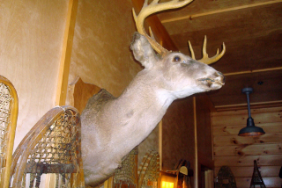 In the first two parts of this taxidermy series, I mentioned the importance of finding a good taxidermist and how to prevent ending up with a bad taxidermist. Finding the right taxidermist helps insure a strong industry full of reputable transactions, and it helps not to reward shady operators and scoundrels. In Part 2, I mentioned how to avoid choosing the wrong taxidermist. Here are a few questions to ask once you have found a taxidermist who is good at business.
In the first two parts of this taxidermy series, I mentioned the importance of finding a good taxidermist and how to prevent ending up with a bad taxidermist. Finding the right taxidermist helps insure a strong industry full of reputable transactions, and it helps not to reward shady operators and scoundrels. In Part 2, I mentioned how to avoid choosing the wrong taxidermist. Here are a few questions to ask once you have found a taxidermist who is good at business.
What exactly is your turn-around time on a mount? This question will be met with appreciation by a good taxidermist, but the wrong taxidermist will be slightly offended with this question. Why? Because the good guy will actually have a reliable history of taking in specimens and they know their actual time-table for mount completion.
The wrong taxidermist will be defensive and he or she will adopt a ‘me against the world’ mentality that makes it easier to insist that customers don’t understand how long things take. This will be an easily recognizable red flag that you should avoid. After all, taxidermy is art and you can’t put a time-table on art. Not. Taxidermy is a craft, like brick laying or carpentry and all crafts can be artful, but taxidermy has a schedule and a set cost.
Who does your tanning? This is an excellent question that will tell you way more than you can imagine about a taxidermist. Tanning is the most important action that will be performed on any mount, and although a small number of taxidermists can pull off decent tans on their own, most pros send out salted and prepped skins to reputable tanneries to get the very best tans available. There are a handful of awesome tanneries in the country and they specialize in one thing, tanning skins. Trust me, you want your taxidermist to using the best tanneries to help ensure that your mount is high quality.
Don’t be seduced by ‘home tans’ or tans that use dry preservative. If your potential taxidermist says he does all his own tanning, ask him what kind of tan he does. Even if you don’t know what he is talking about, this will give him a chance to explain his tanning process while you take mental notes and hit the internet afterwards. Be careful and if a taxidermist ever admits to using dry preservative, run for the hills and don’t leave your specimen there. Dry preservative is a powder that is rubbed into the skin and it is only a temporary way to preserve skin at best. At worst, it will help make sure your skin rots, cracks and falls apart in a short amount of time.






